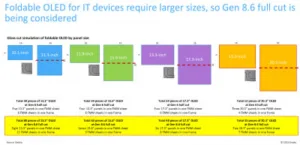OLED display technology is continuing to advance for next generation products. A glimpse of that was seen through various presentations at the OLEDs World Summit 2022 conference in October this year. Technology development, improvements in materials and manufacturing technologies combined with capacity expansion will help OLED displays to gain higher market share in the future.

This year, Jason Hartlove, from Nanosys, in his keynote presentation for the combined session of Phosphorus and Quantum Dot Industry Forum and OLEDs World Summit posed a thought-provoking question for the industry:
“How can we use technologies to dramatically improve the way our products are interacting with us and with our environment with the big challenge facing us today?’
Can Technology Advances in the Display Industry Help to Solve Global Challenges?
Nanosys is the world’s leading QD (Quantum Dot) material developer and manufacturer. According to Nanosys’s CEO, Jason Hartlove’s presentation, the most important challenges that need to be addressed are:
- The twin Threats of global warming and energy security
- Human health and wellbeing
- Stewardship of the environment
He said
“the twin threats of global warming and energy security’s impact are already coming into display industry. Recent changes in the energy standards in Europe, have basically made it all but impossible for 8K TV to be sold in Europe next year.
Displays are 4.6% of US household electricity consumption. Displays also account for up to 40% of CE energy use”.
Data from his presentation showed that heavy metal free (HMF) QD displays deliver best in class power efficiency. His call for action for the display industry is to,
“create designs using OLED, HMF QDs and Phosphors which use less energy- potential impact – global 1% energy use reduction”.
For “human health and wellbeing” challenge he said
“motion to photon lag is the leading cause of cybersickness.”
His suggestion was,
“displays should strive for >90hz and <<13ms latency for good experiences”.
For the environmental challenges, he said
“non-heavy metal materials exist and are often superior in performance”.
His message for the industry was –
“Design for efficiency, human wellness and sustainability”.
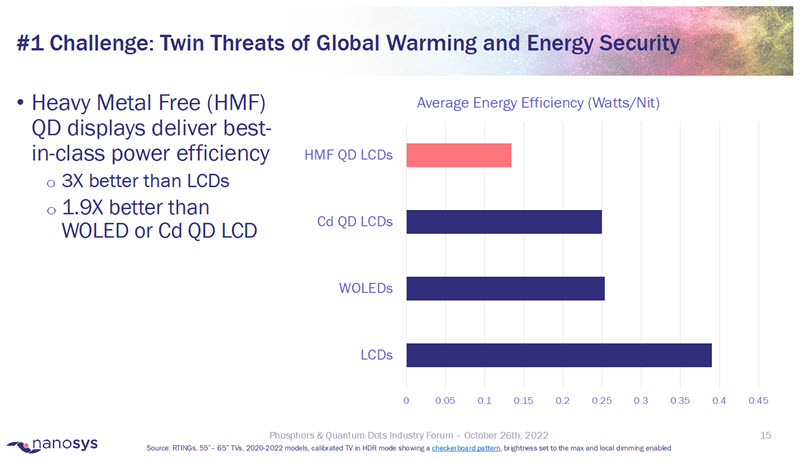 Source: Nanosys-OLEDs World Summit 2022
Source: Nanosys-OLEDs World Summit 2022
Materials and Manufacturing Technology – Improving
Mike Hack from UDC said,
”there are continuing advances inventing and developing next-generation materials with increasing energy-efficiencies with proven lifetimes for reduced power consumption and enhanced sustainability”.
UDC has announced that they expect to meet preliminary target specs with their phosphorescent blue by year-end, enabling the introduction of all-phosphorescent RGB stacks into the commercial market in 2024.
He said that key benefits to completing the full color spectrum of high efficiency by phosphorescence (PHOLED) includes: reduced power consumption, extended battery life, higher brightness, lower panel temperature and increased sustainability. UDC also reported a research breakthrough in Plasmonic OLED that can dramatically increase the stability of all colors of PHOLED. It can also leverage plasmonics to enable faster decay of excitons and recover the energy using an outcoupling scheme.
He presented that,
“the plasmonic PHOLED, a new OLED architecture, will enable another leap in OLED efficiency and lifetime”.
UDC has also developed organic vapor jet printing (OVJP), a solventless, maskless, printing technology for patterning small molecule organic materials to manufacture large area side by side RGB TVs. Qiongying Hu, from Coherent presented that their Excimer Laser Annealing (ELA) is the foundation for advanced LTPO (LTPS+Oxide) enabling high frame rates of >100Hz. Laser processes are also integral part of flexible displays.
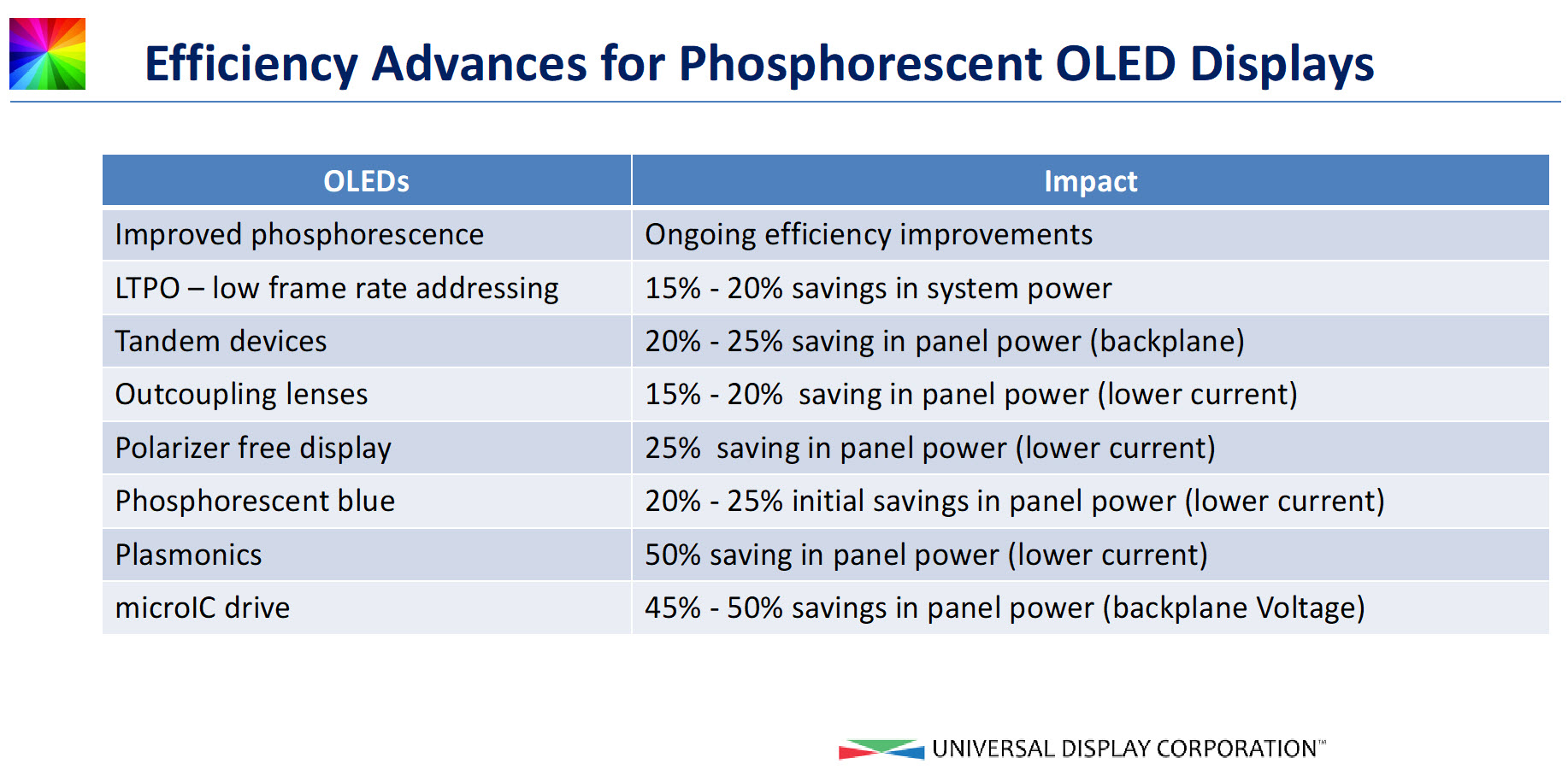 Source: UDC-OLEDs World Summit 2022
Source: UDC-OLEDs World Summit 2022
Next Gen Technology for TV – Evolving
LG Display, the leader for OLED TV panels, has been continuously improving WOLED technology, increasing the size offerings, expanding capacity and increasing shipments especially in the premium/high-end TV market. LGD has introduced its most advanced OLED panel with EX technology.
According to J.J. Yoo, from LG Display,
“EX technology has 30% higher brightness (by applying deuterium, creating more stable and robust structure), 30% increase in reliability (by personalized algorithm, sensing plus counting based on AI and Big data) and 34% narrower bezel (by applying highly integrated GIP tech design)”.
Yoo presented that OLED has accurate HDR performance (100% pixel dimming), 100% color fidelity, eye comfort and eye safe (low blue light and flicker free), and is eco-friendly (less harmful substance and high recyclability). He said that nextgen OLED will have microlens arrays, high mobility oxide backplanes, high efficiency OLED materials, real-time compensation and will be bezel-less. LGD has also developed transparent OLED which can open up opportunities in signage, architecture, mobility and home style market.
Samsung Display has introduced QDOLED (heavy metal-free printed QDs) this year in 34/55/65inch sizes that deliver increased display performance, higher brightness and better color gamut. Sony and Samsung Electronics are already selling 55 and 65-inch QDOLED TVs. Dell has launched 34-inch ODOLED monitor for the gaming market. According to Hartlove’s presentation with equal luminance between QDLCD and QD OLED, QDOLED is rated as brighter. QD OLED can deliver more perceived brightness with less power.
Jerry Kang from OMDIA presented that SDC is planning to pattern QDCC directly on OLED encapsulation for 2nd generation QD OLED, thereby it can shift from two glass substrate to one glass sheet. This will make it thinner and more efficient. Longjia Wu, from TCL Research presented on his company’s progress for inkjet printed IJP QLED (QD emissive) display. TCL expects mass production in the 2024–2025 time frame.
These technology developments for the TV application will help to meet power consumption challenges in future. Higher brightness and high resolutions (8K) requirements have increased the power requirements. Now the industry is facing challenges and has to focus more on power savings by improving materials and processes.
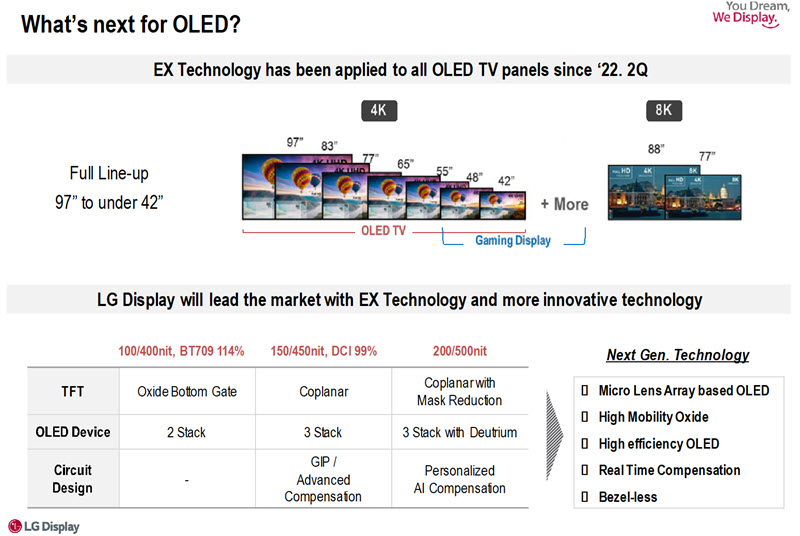 Source: LGD-OLEDs World Summit 2022
Source: LGD-OLEDs World Summit 2022
Next Gen Technology for IT – Expanding
In Omdia presentation, Jerry Kang said,
“Gen6 & larger generation, OLED Panel makers are developing a few new technologies to apply to Tablet PC & Notebook PC.
- Hybrid OLED Structure with glass substrates + TFE encapsulation
- Flexible OLED structures for foldable / rollable form factor
- RGB tandem stack OLED structures
- Gen 8.6 half cut evaporation with Fine Metal Masks (Horizontal)
- Gen 8.6 full cut evaporation with Fine Metal Masks (Vertical)
- LTPO TFT and Oxide TFT with high electron mobility
- Atomic Layer Deposition (ALD) for thin-film encapsulation
- Atomic Layer Deposition for Oxide TFT with high electron mobility”
According to Omdia estimation, Apple is expected to have Hybrid OLED iPad by 2024 and MacBook by 2026. Gen8 production is required for better productivity of IT OLED. As per Omdia estimation, Gen8.6 pilot will start in 2024 and OLED panel shipments for notebook and Tablet expected to have strong growth in next 5 years. Jerry Kang said,
“foldable OLEDs for IT devices require larger sizes, so Gen 8.6 full cut is being considered.”
Suppliers are considering from above 10-inch sizes to above 20-inch sizes for for foldable IT products. Kunjal Parikh from Intel mentioned that Intel Evo™ design has foldable display specs requirements. He said,
“the Intel Visual Sensing Controller helps enable users to have a secure, responsive, immersive, and power-efficient PC without compromising on performance, quality, or battery life by using smart sensing solutions to intelligently manage power consumption and deliver great user experiences”.
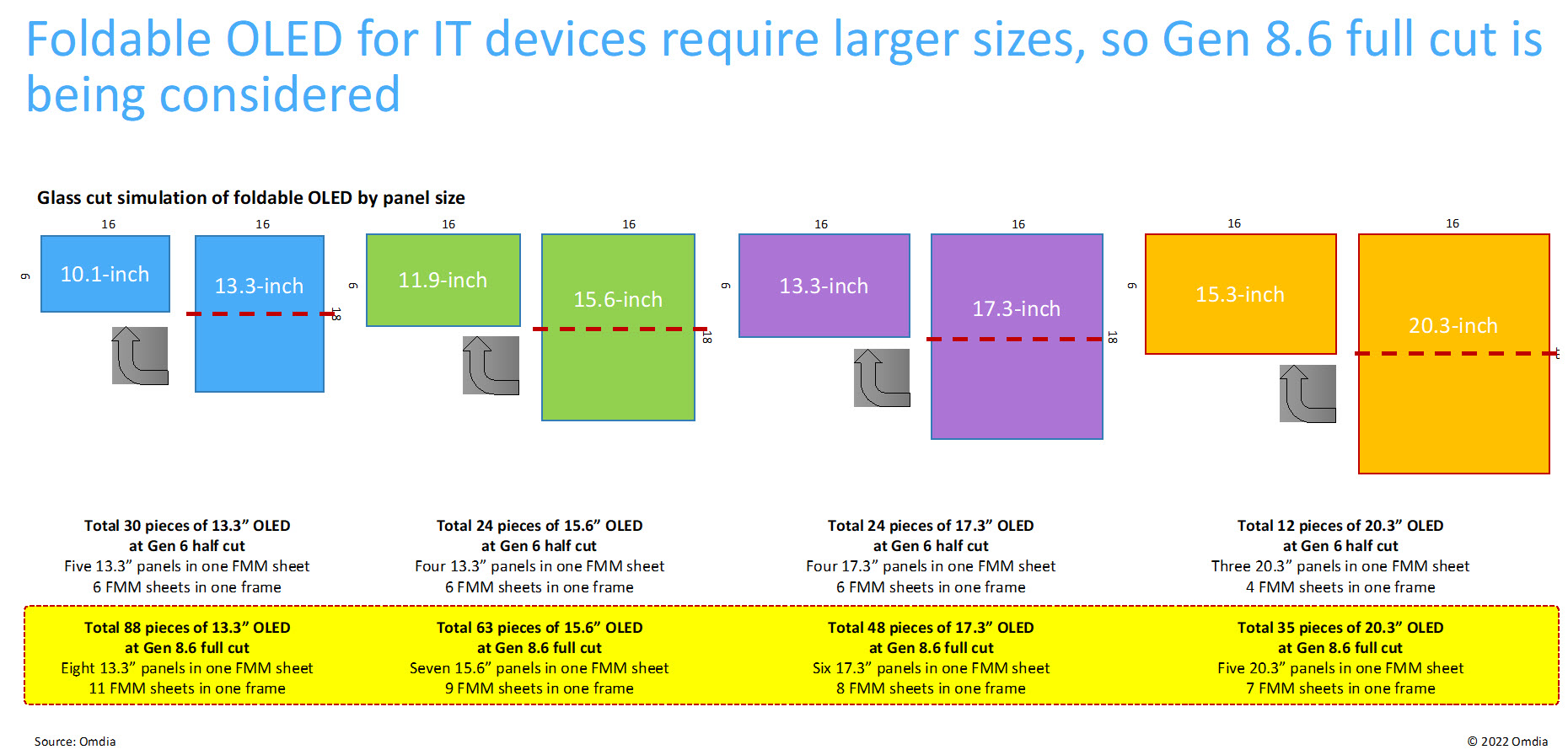 Source: OMDIA: OLEDs World Summit 2022 – click for higher resolutionNext Gen Technology for Smart Phones – Progressing
Source: OMDIA: OLEDs World Summit 2022 – click for higher resolutionNext Gen Technology for Smart Phones – Progressing
The Omdia presentation on smartphone shipments with ifs forecast, showed that the market is down again this year due to sluggish demand. However, OEMs are continuing to increase the adoption of high refresh rate displays. Apple has already adopted LTPO substrates for the iPhone 13 (Pro and Pro Max) and also for iPhone 14 (Pro and Pro Max). Samsung Galaxy products are already using LTPO technology which has big advantages in lower power consumption and variable refresh rates.
According to Kang’s presentation – OTI Lumionic’s CPM (Cathode Patterning Material) process will be useful for under panel camera structures. CPM works with standard OLED cathode materials, requiring no change in OLED stack implementation. Samsung Display has also introduced its new “Eco2OLED” technology, which dramatically reduces the power consumptions of panels. It removes the polarizer applied to the panel to increase light transmittance and optimizes the pixel structure to control external light reflection.
Samsung Display’s Eco2OLED operates at 86.8% power consumption level compared to conventional and Eco2OLED Plus operates at 74.3% level. The Omdia presentation showed that almost all mainstream brands (except Apple, of course – Editor) have joined the foldable smartphone competition and are accelerating the expansion of product line-ups. For foldable cover lenses, Samsung is using ultra-thin glass while some brands are trying thinning solutions. Foldable smartphones are forecast to grow in the next 7 years according to Omdia even though the 2022 outlook is below the original forecast.
The presentations from the OLED Summit gave a glimpse of next generation OLED technology and what to expect in future. They showed that suppliers are working towards improving performance while reducing power consumption and making it better for health and the environment but will take time to implement. The question still remains of whether the current progress in the display industry will be enough and can be implemented in a timely manner to meet today’s most important challenges? (SD)
Sweta Dash, President, Dash-Insights
Sweta Dash is the founding president of Dash-Insights, a market research and consulting company specializing in the display industry. For more information, contact [email protected] or visit www.dash-insights.com

